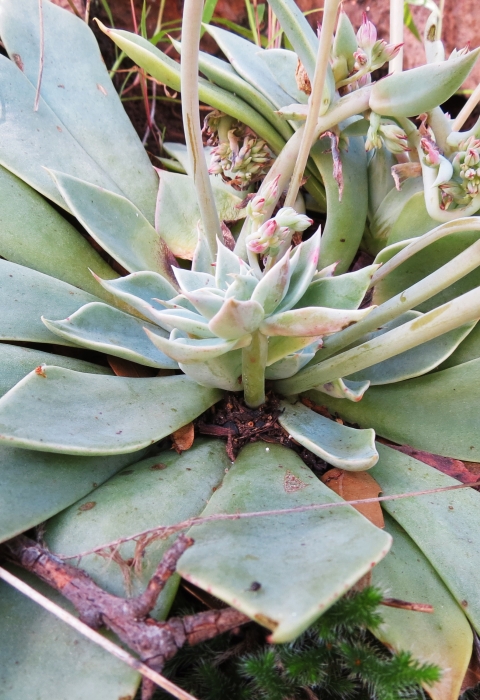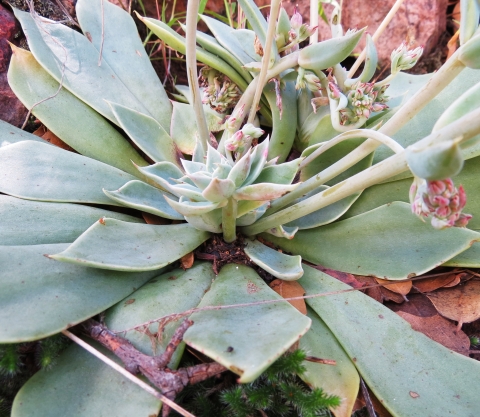The U.S. Fish and Wildlife Service is releasing the draft recovery plan for the threatened Bartram's stonecrop, a plant found in isolated mountain ranges of southern Arizona and northern Mexico. The draft recovery plan focuses on the restoration of the species, its woodland habitat and its natural wildfire regime. A 60-day public comment period will close on Oct. 11, 2024.
Bartram's stonecrop was listed as threatened without designated critical habitat in 2021. Within the United States, Bartram’s stonecrop occurs mostly on federally-managed land. Historically, 53 separate populations within 13 isolated sky island mountain ranges were documented. Now, four of these populations no longer exist in Arizona and other populations are in decline. A single catastrophic event could eliminate smaller populations.
Bartram's stonecrop is a stemless succulent that grows low to the ground with 20 or more leaves arranged in a small rosette. The plant’s genus, Graptopetalum, is derived from the Greek words “graptos” (inscribed) and “petalon” (petals) and aptly describes the red stripes on its yellow petals. After the autumn rains, its five-petal flowers bloom, attracting various pollinators such as flies, honey bees, wasps and butterflies.
Succulents are usually thought of as desert plants; however, Bartram's stonecrop grows alongside moss, needing shade and moisture. The plant typically grows in rock crevices on steep slopes near springs and streams at high elevations. The cooler temperatures and higher humidity found in the narrow canyons and shade from Madrean forests provide a more hospitable microhabitat.
“The recovery plan for Bartram’s stonecrop gives us flexibility,” said Julie Crawford, plant ecologist with the Service’s Arizona Ecological Services Field Office. “The plan has an option for recovery that allows us to achieve the conservation of more plant populations with fewer individuals in them or fewer plant populations with more individuals in them. In addition, we need genetic analysis to guide us in effective recovery efforts. Genetic studies of Bartram’s stonecrop have not yet been performed, and the recovery plan calls for it.”
Recovery plans are not regulatory. Rather they provide both a framework for guiding a species’ recovery and the criteria we expect will indicate that federal protection is no longer necessary. The recovery plan is just one piece of a three-part framework and is informed by the Species Status Assessment and is implemented via the Recovery Implementation Strategy.
Recovery actions address threats to the species including, but not limited to, habitat loss and alteration, drought and climate change climate change
Climate change includes both global warming driven by human-induced emissions of greenhouse gases and the resulting large-scale shifts in weather patterns. Though there have been previous periods of climatic change, since the mid-20th century humans have had an unprecedented impact on Earth's climate system and caused change on a global scale.
Learn more about climate change . Besides woodland habitat and wildfire regime restoration, additional recovery actions for the Bartram's stonecrop’s draft recovery plan include collaborating with partners to collect seeds, propagate plants, develop transplanting techniques and introduce Bartram’s stonecrop seeds and plants into appropriate microhabitats. In addition, the plan calls for surveys, monitoring, research, and improving our understanding of necessary management actions.
The draft recovery plan can be found online at ecos.fws.gov/ecp/species/8382. The Service will consider comments received by Oct. 11, 2024. The Service encourages the public, federal and state agencies, Tribes, and other stakeholders to review the draft recovery plan and provide comments.




